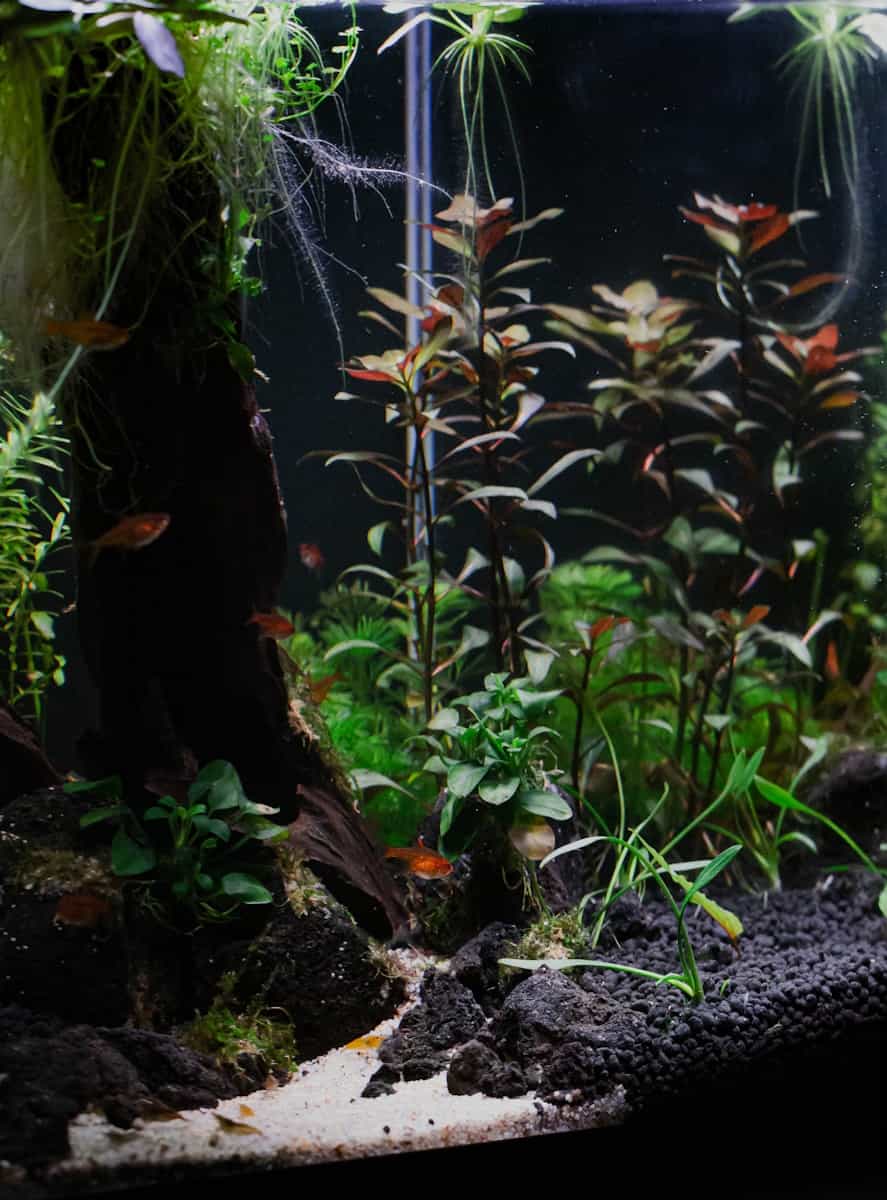The 7 Best Nano Fish for Aquascaped Tanks
Aquascaping is the art of creating beautiful underwater landscapes in fish tanks. It involves carefully arranging plants, rocks, and other decorations to create a visually appealing and natural-looking environment. Nano fish, also known as small fish, are a popular choice for aquascaped tanks due to their small size and vibrant colors. In this article, we will explore the 7 best nano fish for aquascaped tanks.
Aquascaping has gained significant popularity in recent years as more and more people are discovering the joy of creating their own underwater worlds. The art of aquascaping goes beyond simply keeping fish in a tank; it is about creating a miniature ecosystem that mimics the beauty and tranquility of natural aquatic habitats.
One of the key elements in aquascaping is the choice of fish. Nano fish, which are typically less than 2 inches in length, are ideal for aquascaped tanks due to their small size and ability to thrive in smaller environments. These tiny fish not only add a splash of color to the tank but also help create a sense of depth and balance in the overall design.
When selecting nano fish for an aquascaped tank, it is important to consider their compatibility with other tank inhabitants and their ability to adapt to the specific water conditions and plant life in the tank. Some nano fish are known for their peaceful nature and can coexist with other fish species, while others may be more territorial and aggressive.
In this article, we will highlight the 7 best nano fish for aquascaped tanks, taking into account their compatibility, coloration, and ease of care. From the vibrant hues of the Scarlet Badis to the graceful movements of the Celestial Pearl Danio, these fish species will not only enhance the visual appeal of your aquascaped tank but also create a harmonious and balanced ecosystem.
So, whether you are a beginner looking to start your first aquascaped tank or an experienced hobbyist looking to add some new residents to your existing setup, read on to discover the top nano fish species that will bring your underwater landscape to life.
1. Endler’s Livebearer
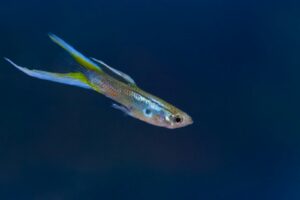
Endler’s Livebearer is a small and colorful fish that is perfect for aquascaped tanks. They are known for their vibrant colors and active nature. Endler’s Livebearers are relatively easy to care for and can adapt to a wide range of water conditions. They are also peaceful and can live peacefully with other small fish in a community tank.
When it comes to their appearance, Endler’s Livebearers are truly a sight to behold. The males are particularly striking, with their bold and vibrant colors. They often display a combination of metallic blues, fiery reds, and vibrant yellows, which create a stunning visual display in any aquarium. The females, on the other hand, are less colorful but still possess a subtle beauty with their silver bodies and hints of color on their fins.
One of the most fascinating aspects of Endler’s Livebearers is their behavior. These fish are incredibly active and love to explore every nook and cranny of their tank. They are constantly on the move, darting back and forth, and their playful nature adds a lively energy to any aquarium. Watching them swim gracefully through the water, their colors shimmering in the light, is a mesmerizing experience that can captivate any observer.
In terms of care, Endler’s Livebearers are relatively undemanding. They can thrive in a wide range of water conditions, although they prefer slightly acidic to neutral pH levels. They are also quite adaptable to different temperatures, making them suitable for both tropical and coldwater setups. These fish are generally hardy and can tolerate minor fluctuations in water parameters, but it’s always best to maintain stable conditions to ensure their well-being.
When it comes to tankmates, Endler’s Livebearers are peaceful and can coexist with a variety of other small fish species. They are compatible with peaceful community fish like tetras, guppies, and rasboras. However, it’s important to avoid aggressive or fin-nipping species, as they may harass or stress out the Endler’s Livebearers.
In terms of feeding, Endler’s Livebearers are not fussy eaters. They will readily accept a variety of foods, including high-quality flakes, pellets, and frozen or live foods. It’s recommended to provide them with a balanced diet that includes a mix of protein-rich and vegetable-based foods to ensure their nutritional needs are met.
In conclusion, Endler’s Livebearer is a wonderful addition to any aquascape tank. Their vibrant colors, active nature, and peaceful demeanor make them a joy to observe. With their relatively easy care requirements and adaptability to different water conditions, they are suitable for both beginner and experienced fishkeepers. So, if you’re looking to add a splash of color and liveliness to your aquarium, consider adding Endler’s Livebearers to your collection.
2. Celestial Pearl Danios
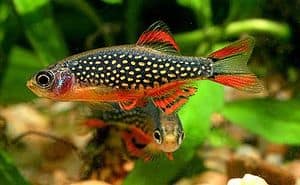
These tiny fish, native to Myanmar, are a true gem in the aquarium hobby. Their small size, reaching only about an inch in length, makes them perfect for nano tanks and small aquarium setups. Despite their small stature, Celestial Pearl Danios are known for their vibrant colors and eye-catching patterns.
The metallic blue body of the Celestial Pearl Danio is truly mesmerizing. It shimmers under the aquarium lights, giving the impression of a starry night sky. The orange and red spots scattered across their body add a pop of color, creating a truly captivating display. It’s no wonder why they are often referred to as “Galaxy Rasboras.”
When it comes to temperament, Celestial Pearl Danios are peaceful and get along well with other small fish. They are not known to be aggressive or territorial, which makes them an excellent choice for community tanks. However, it’s important to note that they are relatively small and delicate, so it’s crucial to choose tankmates that won’t pose a threat to them.
In their natural habitat, Celestial Pearl Danios inhabit slow-moving streams and shallow ponds. They are accustomed to dense vegetation and appreciate a well-planted aquarium. Providing them with plenty of hiding spots and plants will not only mimic their natural environment but also give them a sense of security.
When it comes to water parameters, Celestial Pearl Danios are relatively adaptable. They can tolerate a wide range of pH levels, but a slightly acidic to neutral pH is ideal. The water temperature should be kept between 72 to 78 degrees Fahrenheit (22 to 26 degrees Celsius). It’s also important to maintain good water quality and perform regular water changes to ensure their health and well-being.
Feeding Celestial Pearl Danios is relatively easy, as they are not picky eaters. They will readily accept a variety of foods, including high-quality flakes, pellets, and frozen or live foods. It’s recommended to provide them with a balanced diet that includes both dry and frozen/live foods to ensure they receive all the necessary nutrients.
In conclusion, Celestial Pearl Danios are a fantastic addition to any aquascape or community tank. Their small size, striking appearance, and peaceful nature make them a popular choice among aquarium enthusiasts. With proper care and attention to their specific needs, these little gems will thrive and bring joy to any aquarium they call home.
3. Chili Rasbora
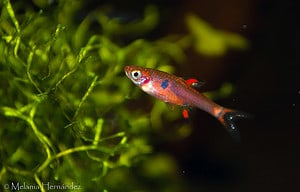
The Chili Rasbora is a tiny fish with a fiery red coloration that adds a pop of color to any aquascaped tank. They are peaceful and can be kept in a community tank with other small, non-aggressive fish. Chili Rasboras prefer densely planted tanks with plenty of hiding spots.
These fascinating little fish, also known as Boraras brigittae, originate from the rivers and streams of Southeast Asia, specifically from the regions of Thailand and Malaysia. They are highly sought after by aquarists due to their vibrant red coloration and their peaceful nature.
In terms of size, Chili Rasboras are quite small, reaching an average length of only 0.8 inches (2 cm). Despite their small size, they have a striking appearance with their bright red bodies and black markings on their fins. It is this vibrant coloration that gives them their name, as they resemble tiny chili peppers swimming gracefully in the water.
One of the reasons why Chili Rasboras are so popular among aquarists is their peaceful temperament. They are known to be extremely peaceful and non-aggressive, making them an excellent choice for community tanks. They can coexist harmoniously with other small, non-aggressive fish such as dwarf shrimp, small tetras, and other rasboras.
To create an ideal habitat for Chili Rasboras, it is important to provide them with a densely planted tank. These fish thrive in an environment that mimics their natural habitat, which consists of dense vegetation and plenty of hiding spots. The presence of live plants not only enhances the aesthetic appeal of the tank but also provides the fish with places to hide and explore.
In addition to live plants, it is recommended to include some floating plants in the tank to provide shade and create a more natural environment. This will also help to diffuse the light and reduce any potential stress for the fish.
When it comes to water parameters, Chili Rasboras prefer slightly acidic to neutral water conditions. The recommended pH range for these fish is between 6.0 and 7.0, with a water temperature ranging from 75°F to 82°F (24°C to 28°C). It is important to maintain stable water conditions and perform regular water changes to ensure the health and well-being of the fish.
In terms of diet, Chili Rasboras are omnivorous and will readily accept a variety of foods. They can be fed a combination of high-quality flakes, pellets, and frozen or live foods. It is important to provide them with a balanced diet that includes both protein-rich and plant-based foods to ensure their nutritional needs are met.
4. Ember Tetra
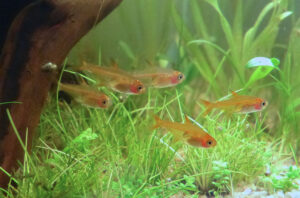
Ember Tetras are small, peaceful fish that are perfect for aquascaped tanks. They have a vibrant orange color that stands out in any aquarium. Ember Tetras are social and should be kept in a school of at least six individuals. They prefer tanks with plenty of plants and hiding spots.
Ember Tetras, scientifically known as Hyphessobrycon amandae, are native to the Araguaia River basin in Brazil. These tiny fish, measuring only about an inch in length, have become increasingly popular among aquarists due to their striking appearance and peaceful nature. Their bright orange coloration, reminiscent of glowing embers, adds a lively touch to any aquatic environment.
In the wild, Ember Tetras inhabit slow-moving rivers and streams, where they can be found among dense vegetation and submerged tree roots. To replicate their natural habitat in an aquarium, it is essential to provide them with plenty of plants and hiding spots. Dense plantings of species like Java moss, Amazon sword, and water sprite not only mimic their natural environment but also offer them places to retreat and feel secure.
Keeping Ember Tetras in a school of at least six individuals is crucial for their well-being. These fish are highly social and thrive in the company of their own kind. When kept in smaller groups or as solitary individuals, they may become stressed and display less vibrant colors. By maintaining a proper school size, aquarists can ensure that their Ember Tetras exhibit their full potential in terms of coloration and behavior.
Ember Tetras are generally peaceful and can coexist with a variety of tankmates, including other small, non-aggressive fish species. However, it is essential to avoid housing them with larger, more aggressive fish that may see them as potential prey. Suitable tankmates for Ember Tetras include small tetras, rasboras, guppies, and dwarf shrimp. It is important to research the compatibility of potential tankmates to ensure a harmonious and stress-free community.
In terms of water parameters, Ember Tetras prefer slightly acidic to neutral water conditions. A pH range of 6.0-7.0 and a temperature between 72-80°F (22-27°C) are ideal for their well-being. Regular water changes and the use of a reliable filtration system are necessary to maintain optimal water quality.
Feeding Ember Tetras is relatively straightforward as they are omnivorous. They readily accept a variety of commercial flake, pellet, and freeze-dried foods. Supplementing their diet with live or frozen foods such as brine shrimp, daphnia, and bloodworms will help enhance their coloration and overall health.
5. Pygmy Corydoras
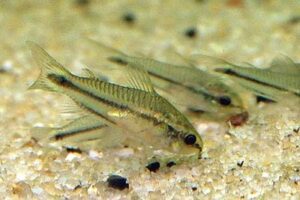
One of the fascinating aspects of Pygmy Corydoras is their unique appearance. They have a sleek and slender body, with a vibrant coloration that can range from shades of bronze to green. Their bodies are adorned with striking patterns, such as spots or stripes, which make them stand out in any aquarium.
These small fish are native to the rivers and streams of South America, particularly in the Amazon basin. They are well adapted to life in slow-moving waters with dense vegetation, which makes them a perfect fit for aquascaped tanks. Pygmy Corydoras thrive in environments that mimic their natural habitat, with plenty of hiding places and soft substrate.
When it comes to tank mates, Pygmy Corydoras are extremely peaceful and get along well with other small, non-aggressive fish. They are social creatures and should be kept in groups of at least six individuals. The presence of a group allows them to feel more secure and encourages their playful behavior.
Pygmy Corydoras are not picky eaters and will readily accept a variety of foods. They have a preference for small live or frozen foods like bloodworms and brine shrimp, but they will also consume high-quality flake or pellet foods. It is important to provide them with a balanced diet to ensure their overall health and vitality.
These fish are relatively easy to care for, making them a popular choice among aquarists of all skill levels. They are not demanding in terms of water parameters, but it is crucial to maintain stable conditions. Pygmy Corydoras prefer slightly acidic to neutral water with a temperature range of 72-78°F (22-26°C).
Overall, Pygmy Corydoras are a delightful addition to any aquascape. Their small size, peaceful nature, and playful behavior make them a joy to watch. Whether you are a beginner or an experienced aquarist, these charming little fish will surely bring life and vibrancy to your underwater masterpiece.
6. Scarlet Badis
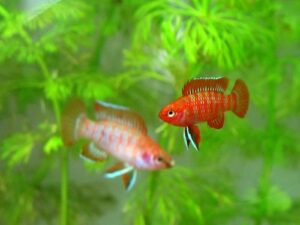
The Scarlet Badis is a small and colorful fish that is perfect for aquascaped tanks. They have a vibrant red coloration with blue and black stripes. Scarlet Badis are relatively hardy and can adapt to a wide range of water conditions. They prefer densely planted tanks with plenty of hiding spots.
The Scarlet Badis, also known as Dario dario, is native to the slow-moving waters of India, particularly the Brahmaputra and Ganges river basins. This species belongs to the family Badidae, which includes other popular aquarium fish like the Badis badis and Dario hysginon.
One of the most striking features of the Scarlet Badis is its vibrant red coloration. The males are particularly stunning, displaying intense hues of crimson and scarlet that are sure to catch the eye of any observer. In contrast, the females have a more subdued coloration, with shades of orange and brown.
Apart from their striking appearance, Scarlet Badis are relatively hardy and easy to care for. They can thrive in a wide range of water conditions, although they prefer slightly acidic to neutral water with a pH level between 6.0 and 7.5. The temperature should be maintained between 72°F and 80°F (22°C to 27°C) to ensure their optimal health and well-being.
In their natural habitat, Scarlet Badis inhabit shallow waters with dense vegetation and leaf litter. Therefore, replicating this environment in the aquarium is crucial for their overall well-being. Aquascaped tanks with plenty of live plants, driftwood, and rocks provide them with ample hiding spots and mimic their natural habitat. Additionally, a sandy substrate is recommended to resemble the soft riverbeds they are accustomed to.
These fish are relatively peaceful and can be kept in community tanks with other small, non-aggressive species. However, it is important to note that Scarlet Badis are known to be territorial, especially during breeding season. Therefore, providing each male with its own territory and multiple females is essential to prevent aggression and ensure a harmonious tank environment.
Feeding Scarlet Badis is relatively easy, as they are omnivorous and will readily accept a variety of foods. Their diet should consist of high-quality dry flakes or pellets supplemented with live or frozen foods such as brine shrimp, bloodworms, and daphnia. Offering a varied diet not only ensures their nutritional needs are met but also enhances their coloration and overall health.
Breeding Scarlet Badis can be a rewarding experience for aquarists. The males are known for their elaborate courtship displays, where they flare their fins and intensify their coloration to attract females. Once a pair has formed, the female will lay a small number of eggs, which the male will guard and tend to until they hatch. Providing suitable spawning conditions, such as dim lighting and floating plants for the female to deposit her eggs, can increase the chances of successful breeding.
7. Dwarf Pencilfish
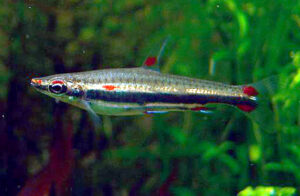
Dwarf Pencilfish, also known as Nannostomus marginatus, are a popular choice among aquarists for their small size and peaceful nature. These fish are native to the Amazon River basin in South America and are commonly found in slow-moving streams and flooded forest areas. They have a slender body shape, which allows them to navigate easily through dense vegetation in their natural habitat.
One of the most striking features of Dwarf Pencilfish is their vibrant coloration. While their base color is typically silver, they display beautiful hues of red, yellow, and green, which can vary depending on their mood and environment. This makes them an excellent addition to aquascaped tanks, as their colorful presence adds visual interest and liveliness to the overall aesthetic.
In terms of behavior, Dwarf Pencilfish are known to be peaceful and sociable. They thrive when kept in a school of at least six individuals, as this mimics their natural shoaling behavior. Being in a group provides them with a sense of security and allows them to exhibit their natural behaviors more confidently. Additionally, observing a school of Dwarf Pencilfish swimming together is a mesmerizing sight, as they move in perfect synchrony, creating a sense of harmony in the tank.
When it comes to tank setup, Dwarf Pencilfish appreciate a well-planted environment. The presence of live plants not only provides them with hiding spots but also mimics their natural habitat, making them feel more at ease. The plants also help maintain water quality by absorbing excess nutrients and providing oxygen. However, it’s important to leave some open swimming space for these active fish, as they enjoy exploring their surroundings and darting between the plants.
In terms of water parameters, Dwarf Pencilfish prefer slightly acidic to neutral water conditions. A pH range of 6.0-7.0 and a temperature between 75-82°F (24-28°C) are ideal for their overall health and well-being. It’s also important to maintain good water quality by performing regular water changes and monitoring ammonia, nitrite, and nitrate levels.
When it comes to feeding, Dwarf Pencilfish are omnivorous and will readily accept a variety of foods. In their natural habitat, they feed on small insects, worms, crustaceans, and plant matter. In the aquarium, they can be fed a combination of high-quality flake or pellet food, supplemented with live or frozen foods such as brine shrimp, daphnia, and bloodworms. Providing a varied diet ensures that they receive all the necessary nutrients for optimal health and coloration.

